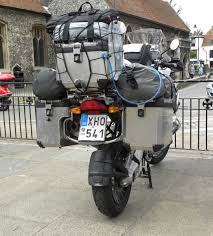
A properly kitted motorcycle can carry quite a lot. I’m not allowed to tell you the things I have carted from A to B on my bike over the years, but even just riding to work you need to carry a briefcase. If a bike cant carry a simple briefcase, its luggage capacity is poor. You would be surprised how many so-called “big” bikes cant carry a simple briefcase. Sooner or later we all want carry things on our motorcycle, if only a spare helmet. So how can you do this safely? A motor-cycle can carry luggage on the:
- Side of the bike (side-panniers/bags)
- Back, behind you (back-pannier or pack-rack).
- Tank, in front of you (tank-rack).
All affect bike balance, width and wind-flow differently, and some need special fitting.
Side-panniers/bags

Side-panniers are popular because they are easy – just open them and drop luggage in. They are fixed form, lockable and waterproof, and usually curved so the wind flows over them. Yet often a square briefcase wont fit into a round side-pannier, nor will a spare helmet. Conversely large side-panniers that carry what you want jut out, making the bike less maneuverable.
Side saddlebags are made of a more flexible material, but often small and again cannot fit a helmet or briefcase. They are not as waterproof as panniers. Carrying luggage in side-panniers or bags can affect the bike’s balance if you only load one side.
Back panniers
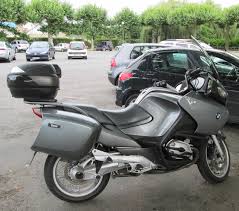
Back panniers sit behind the rider, so the wind resistance problem is less. Nothing juts out on the left/right, so maneuverability is not affected. A weight at the back moves your center of gravity back, but usually not by much. A back pannier is always a good option, even if small, but a pack rack is more flexible.
Pack Rack

My preferred luggage means is a backpack that slides on a pack-rack fitted on the bike. The advantages are:
- Backrest. Even without the backpack, the pack rack is a passenger safety backrest. It stops them falling off the back if you accelerate and they dont hold on, which happens!
- Central. A backpack on the pack rack sits directly behind you, where the passenger normally sits.
- Flexible. If you have a passenger, the pack can flip around to be behind the passenger.
- Mobile. When you arrive, you lift off the pack and walk away.
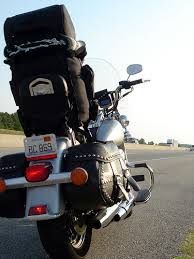
For me, a pack rack and bag is the ultimate luggage flexibility and safety. Putting luggage weight where the passenger sits suits the bike design. It is mobile because when you park, you walk away with the backpack on your shoulder. A good bag is large enough to carry helmet, jacket, leggings and gloves. When you arrive, put your helmet and gloves in the bag, lift it onto your back and walk around hands-free to shop or whatever. Or leave the bag behind a counter knowing your expensive helmet isn’t visible. When traveling, you can add a sleeping bag on top with a bungee cord. And finally, it is the best way to carry a spare helmet if you need to give someone a lift.
Tank Rack
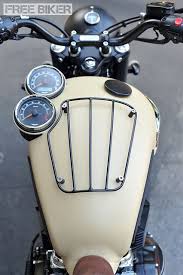
The advantage of carrying stuff on the tank is that it sits centrally and doesn’t affect bike balance. The disadvantage is it wrecks your tank paintwork and you need to hold it in place with something. A tank rack avoids the paint problem and gives a place to bungee cord items on, or hold them between your knees. A tank rack can also attach a small bag to put things you need often, like a map.
Helmet lock
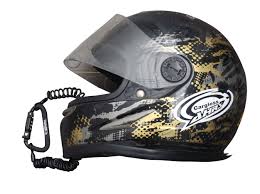
Helmets are awkward things to carry around, and if you drop a helmet on concrete you may have to buy a new one. What to do with your helmet when you arrive is a rider problem, so some bikes have a helmet lock. It lets you lock the helmet on the bike after you stop, so you don’t have to carry it around and no-one can steal it. It was not designed to carry a helmet while riding, so NEVER use it for that. You can get a detachable helmet lock or helmet carry bags, but I prefer to put it in my pack bag and take it with me.
Bungee cords
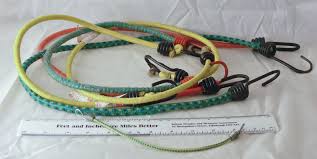
Bungee cords are used to attach luggage to a bike, given somewhere to hook the ends. You can use several cords from several angles, then a final cord to tension the other cords. Even a pack rack bag can bounce off if you hit a big bump. If that happens one cord stretched diagonally will hold it on. I always carry a set of bungee cords for unexpected luggage demands. There are also “bungee nets”, stretchy webs of nylon, that are great for traveling. Bungee cords are the most useful addition to a motorcycle’s carry capacity.
Personal backpack
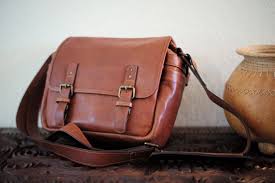
What about putting a pack on your own back to carry things? A small backpack can carry light stuff like a drink but if you are student say, putting a pack full of heavy textbooks on your back and riding to university is a bad idea! The weight on your back strains the body and affects control of the bike, which is dangerous. Not a good idea. A satchel with a long strap that goes around your neck is OK, as you can swing it around to rest on the tank. Lean on it with your tummy so it doesnt move while riding.
What to carry in your jacket?
Here are some things I carry in my jacket when riding:
- Copy of license/insurance – in case you forget your wallet.
- Toll money – coins as needed.
- Tire gauge – to check my tires any time.
- Tissues, lip chap, sun screen and whatever
- Map(s) – for when lost.
- Visor defogger spray/fluid – for hot wet weather.
- Glove liners – Light inner gloves for cold weather or passengers.
- Spare $ – as you never know.
Other just in case things I carry on the bike are:
- Basic tools: pliers, Philips/slot screwdrivers, plug socket, crescent and spanners.
- First aid: Band-aids and antiseptic.
- Balaclava – just in case.
- Wind-breaker – for passengers and just in case.
- Bungee cords – for unexpected luggage.
- Large black plastic bags – to put luggage in when it rains.